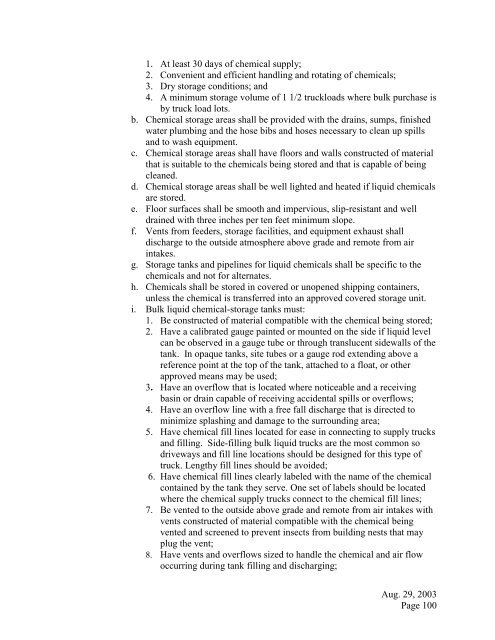Design Guide for Community Water Systems - The Water, Sanitation ...
Design Guide for Community Water Systems - The Water, Sanitation ...
Design Guide for Community Water Systems - The Water, Sanitation ...
You also want an ePaper? Increase the reach of your titles
YUMPU automatically turns print PDFs into web optimized ePapers that Google loves.
1. At least 30 days of chemical supply;2. Convenient and efficient handling and rotating of chemicals;3. Dry storage conditions; and4. A minimum storage volume of 1 1/2 truckloads where bulk purchase isby truck load lots.b. Chemical storage areas shall be provided with the drains, sumps, finishedwater plumbing and the hose bibs and hoses necessary to clean up spillsand to wash equipment.c. Chemical storage areas shall have floors and walls constructed of materialthat is suitable to the chemicals being stored and that is capable of beingcleaned.d. Chemical storage areas shall be well lighted and heated if liquid chemicalsare stored.e. Floor surfaces shall be smooth and impervious, slip-resistant and welldrained with three inches per ten feet minimum slope.f. Vents from feeders, storage facilities, and equipment exhaust shalldischarge to the outside atmosphere above grade and remote from airintakes.g. Storage tanks and pipelines <strong>for</strong> liquid chemicals shall be specific to thechemicals and not <strong>for</strong> alternates.h. Chemicals shall be stored in covered or unopened shipping containers,unless the chemical is transferred into an approved covered storage unit.i. Bulk liquid chemical-storage tanks must:1. Be constructed of material compatible with the chemical being stored;2. Have a calibrated gauge painted or mounted on the side if liquid levelcan be observed in a gauge tube or through translucent sidewalls of thetank. In opaque tanks, site tubes or a gauge rod extending above areference point at the top of the tank, attached to a float, or otherapproved means may be used;3. Have an overflow that is located where noticeable and a receivingbasin or drain capable of receiving accidental spills or overflows;4. Have an overflow line with a free fall discharge that is directed tominimize splashing and damage to the surrounding area;5. Have chemical fill lines located <strong>for</strong> ease in connecting to supply trucksand filling. Side-filling bulk liquid trucks are the most common sodriveways and fill line locations should be designed <strong>for</strong> this type oftruck. Lengthy fill lines should be avoided;6. Have chemical fill lines clearly labeled with the name of the chemicalcontained by the tank they serve. One set of labels should be locatedwhere the chemical supply trucks connect to the chemical fill lines;7. Be vented to the outside above grade and remote from air intakes withvents constructed of material compatible with the chemical beingvented and screened to prevent insects from building nests that mayplug the vent;8. Have vents and overflows sized to handle the chemical and air flowoccurring during tank filling and discharging;Aug. 29, 2003Page 100
















